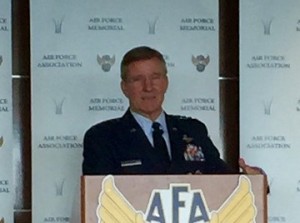2015-06-01 By Robbin Laird
Today, the Commander of the Air Combat Command spoke at an Air Force Association breakfast meeting and discussed the way ahead for the ACC and for airpower more generally.
He argued that today’s fights were seeing demand outstripping the supply of capabilities and clearly this worries him.
And he noted that although there are outside constituencies supporting modernization and force development for USAF assets, the USAF is the main constituency for readiness for USAF airpower and needs to do a better job explaining what this requires.
And readiness of the USAF is a concern in a period of budgetary difficulties with high demand side operational tempos.
The airpower role in the conflict with ISIS was operating within clearly political boundaries but was making an important contribution.

Airpower assets have delivered 4200 strikes and 14,000 weapons to date.
Targets like IED factories (more than 50) and cash cow facilities for ISIS such as oil refineries have been destroyed.
And clearly, airpower has had an impact on the enemy’s ability to mass force and has been able to go after key officials in the hierarchy.
Among significant changes underway was the ability of the USAF and the services to leverage a diversity of sensors from a diversity of platforms to get greater fidelity on targets.
And the USAF had made command changes to more closely integrate “ISR warriors” within the operational community.
The coming of the F-35 was an important element for reshaping USAF air dominance capability and the Marines, the USAF, the USN and the partners are working closely in Fallon, Nellis and Yuma on ways to operate the air craft to enhance operational capabilities.
Next generation weapons are a key part of the modernization matrix, and with regard to directed energy weapons, Carlyle saw these as enhancing survivability of combat assets and then migrating to an offensive capability over time.
With regard to personnel recovery, the USAF is looking at the CV-22 as a possible asset for use in their approach, which would, if acquired, would then mean that the USAF would end up being a mixed rotorcraft and tiltrotar craft fleet for the personnel recovery mission.
And obviously, with a clear interest in NOT having pilots as hostages, the speed and range of an Osprey can be an important asset for the missions.
There were clearly areas like Africa where the speed and range of the Osprey would be extremely important as well.
The F-22s have played an important role in Middle East operations.
They have combined within the fleet strike, ISR, and support capabilities.
He gave an example of one F-22 pilot who within a 12 hour mission during the night, variously conducted strike, ISR, and armed escort missions with several air refuelings during the night mission over Syria and Iraq.
The coalition partners are shaping new approaches and capabilities as well.
Four air forces are tanking using Airbus tankers during operations.
And the GCC plus Jordanian Air Force is are on a rapid learning curve with regard to enhanced operational capabilities.
And in answer to a question about the F-35, Carlyle reinforced the reality seen about the USS WASP:
the ALIS system works and will become a key element for the global supply system.
“For sure, it is a work in progress and will go through a couple of iterations to get where we want to go, but we will get there.”

